
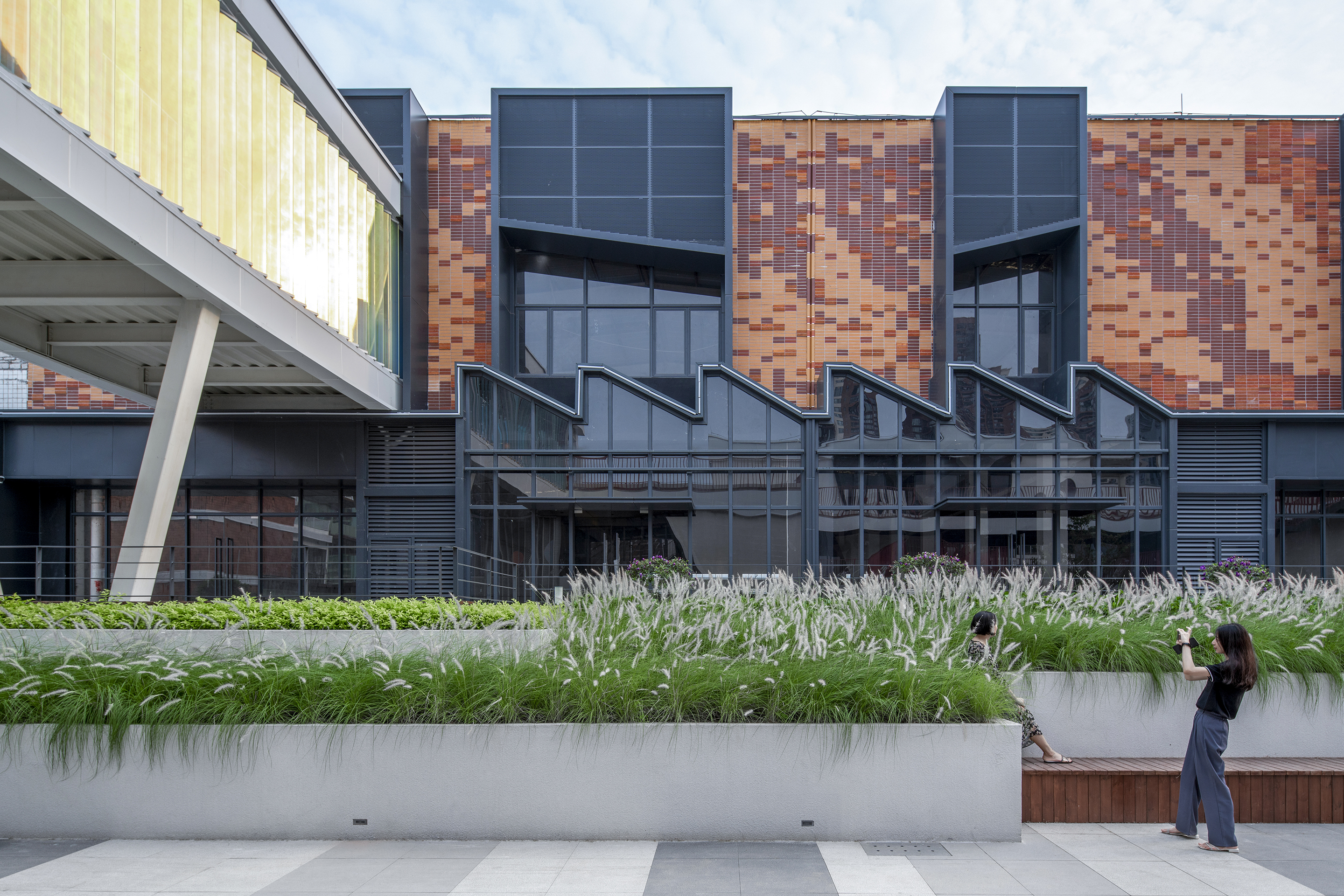
设计单位 竖梁社
项目地点 广东佛山
设计时间 2019年5月—至今
用地面积 79000平方米
本文文字由设计单位提供。
南海新经济小镇位于佛山市南海区桂城街道,项目前身为佛山通储物流中心。随着佛山城市中心的高速发展,位于城市中心的大型仓储中心无疑是对城市中心地带土地资源的一种浪费,同时也不利于城市活力和生活环境的提升,因此仓储物流中心外迁几乎是成为了一个必然的结果。而在物流中心外迁之后,原有大面积的仓储建筑的活化利用,成为了很多城市中心区的一个共同议题。
Haiyi Nanhai New Economic Town is located in the Guicheng Street, Nanhai Suburb, Foshan. The site used to be the Tongchu Logistics Center, however, with the rapid development of the Foshan city, the giant scale of logistics center in the city center has become a problem. It is not only a waste of resources in terms of the limited city land, but also a limitation for improving the living environment and stimulating the vitality of the city. Therefore, the relocation and the renovation of the logistics center is not doubt an inevitable consequences. Especially the potential reuse of the lagre-scale storage area, has become a common issue across a lot of central suburbs.
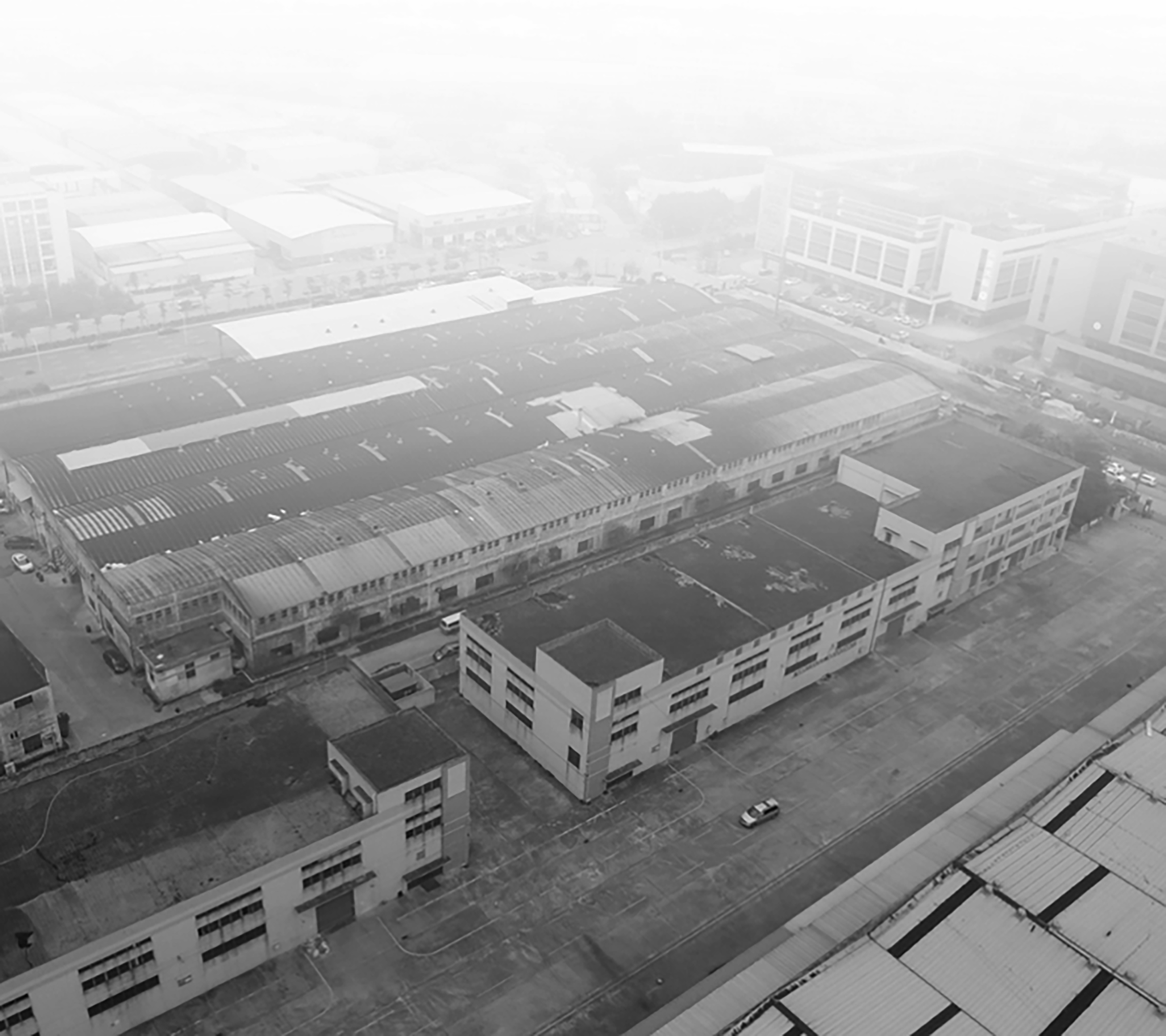
本项目主要是对原佛山通储物流中心内部大量的大跨度仓储建筑进行业态和形态的改造升级,通过引入新型产业和配套业态,并对建筑进行适应性的改造,希望活化空间,将原有消极的大型仓储物流中心,转变为对城市中心地带能带来积极作用的新型产业聚集地。
This project aims to renovate and upgrade a large number of large-scale storage buildings in the existing Tongchu Logistics Center in terms of spacial sequences and architectural forms. By introducing new industries and renovating the architectural spaces, the idle large-scale storage will be reutilised with adapativity and the existing logistics center will be transfored into a new type of industrial complex that can bring positive effects to the city center.
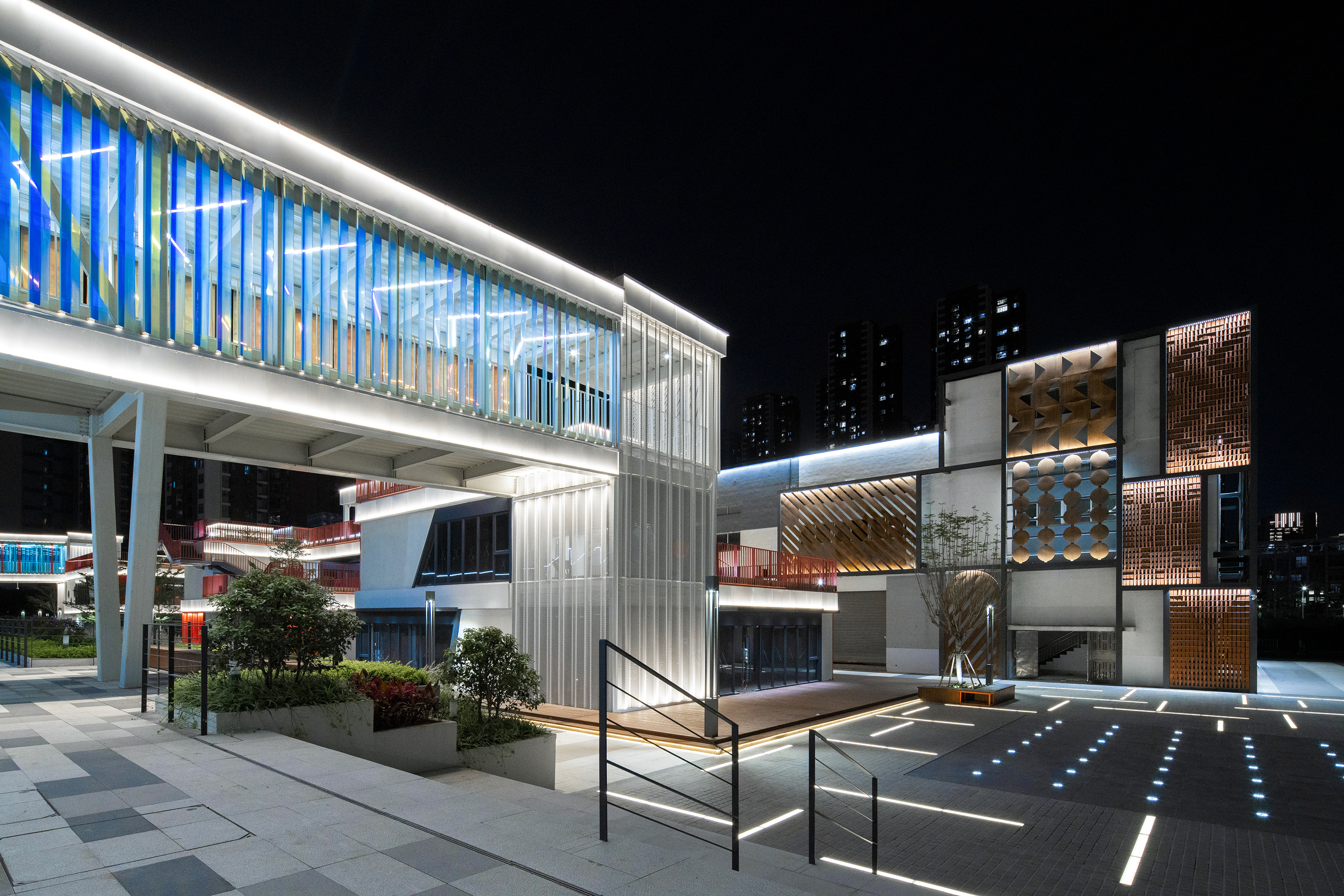


总体规划
仓储物流中心最大的特点,是巨大的尺度,从200米×100米的仓库到45米宽的内部道路,物流中心为货物而设计的尺度如何转化为适宜人使用的尺度,无疑是改造过程中最重要的课题和发力点。
The biggest feature of the Tongshu Logistics Center is its suprisingly long span – the size of a warehouse can be up to 200m*100m and the internal road for transportation is almost 45m wide. Based on this situation, the most important task through the design process is to transform the logistics center from a warehouse that only for goods transpotation to a comfortable space that fits to human scale.
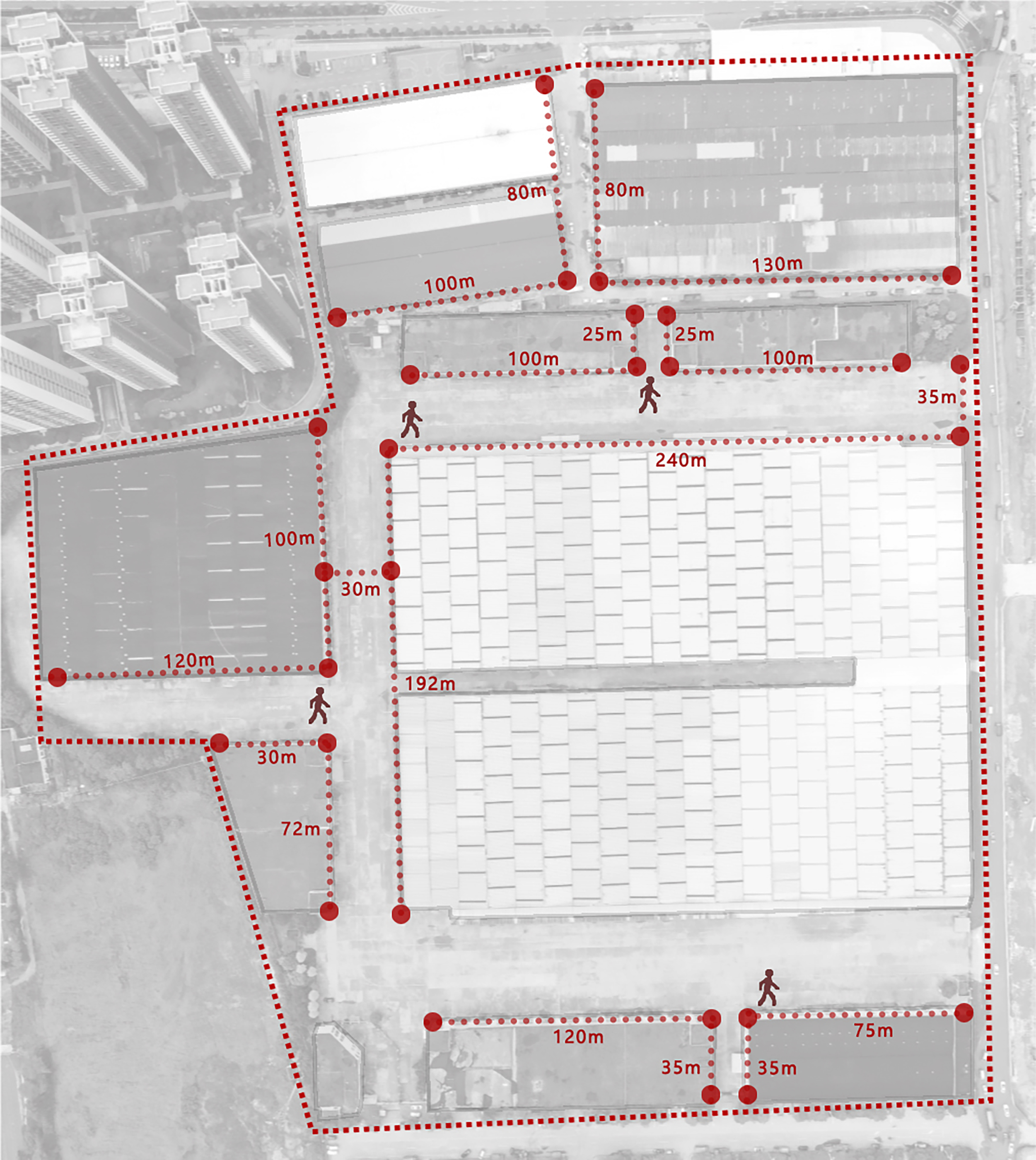
巨大的尺度带来的第一个问题是建筑内部的采光和通风问题,尺度进深过大,通风和采光都无法适应新的业态要求。为了解决建筑内部采光和尺度无法适应新的业态要求的问题,我们在厂房内部置入中庭和院落空间,将巨大的建筑重新划分,并通过中庭和院落重新组织人流动线。
The main concern of the large-span is the lighting and ventilation inside of the building. If the span is too long, the ventilation and lighting conditions cannot meet the requirements of the new industries. Therefore, in order to solve these problems, atrium and courtyard spaces are introduced into the factory to improve the natural lighting and vantilation. The large-scale building is reorganized along the atrium and the courtyard to enusre a smooth movement in between the sapces.

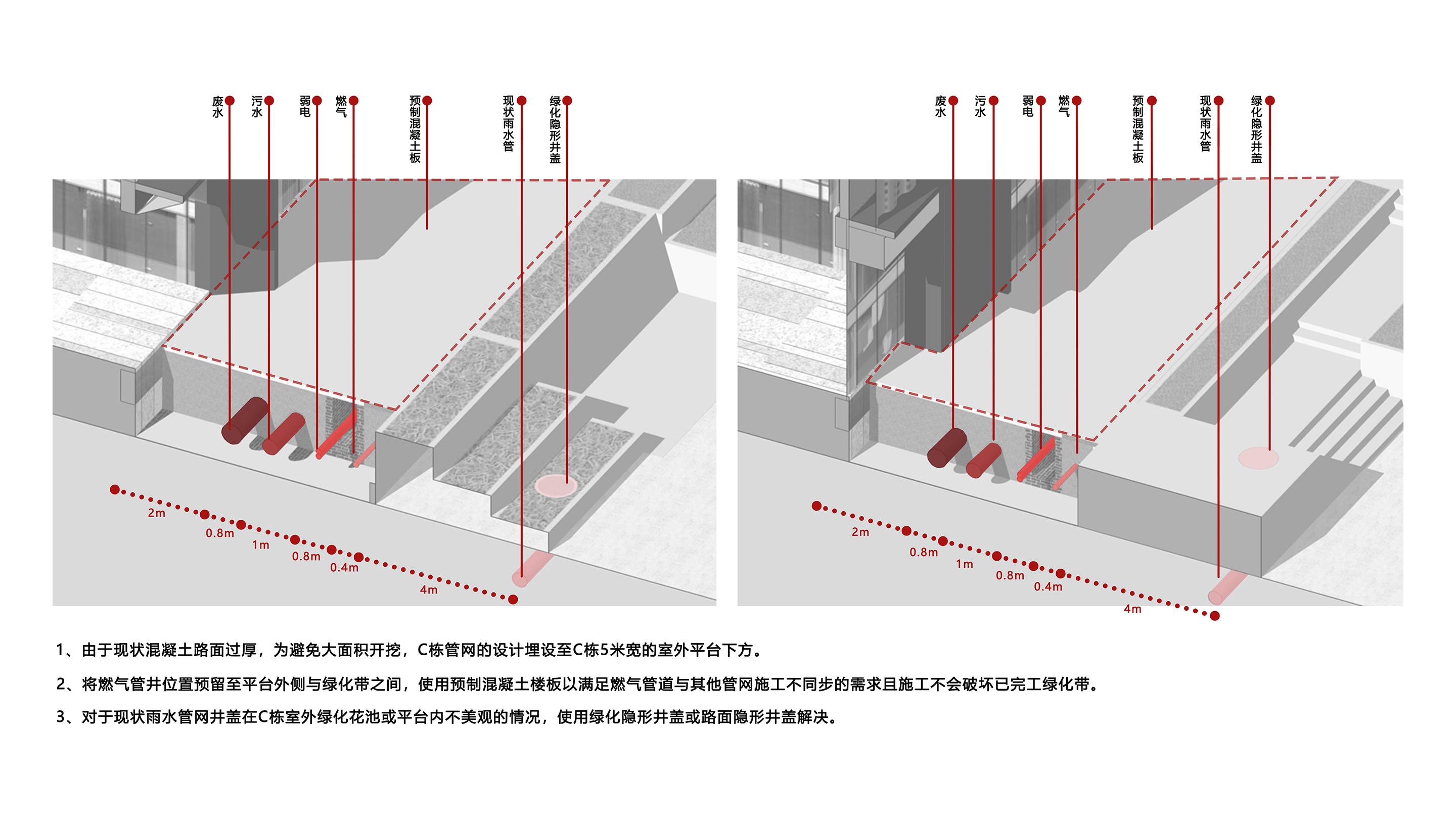
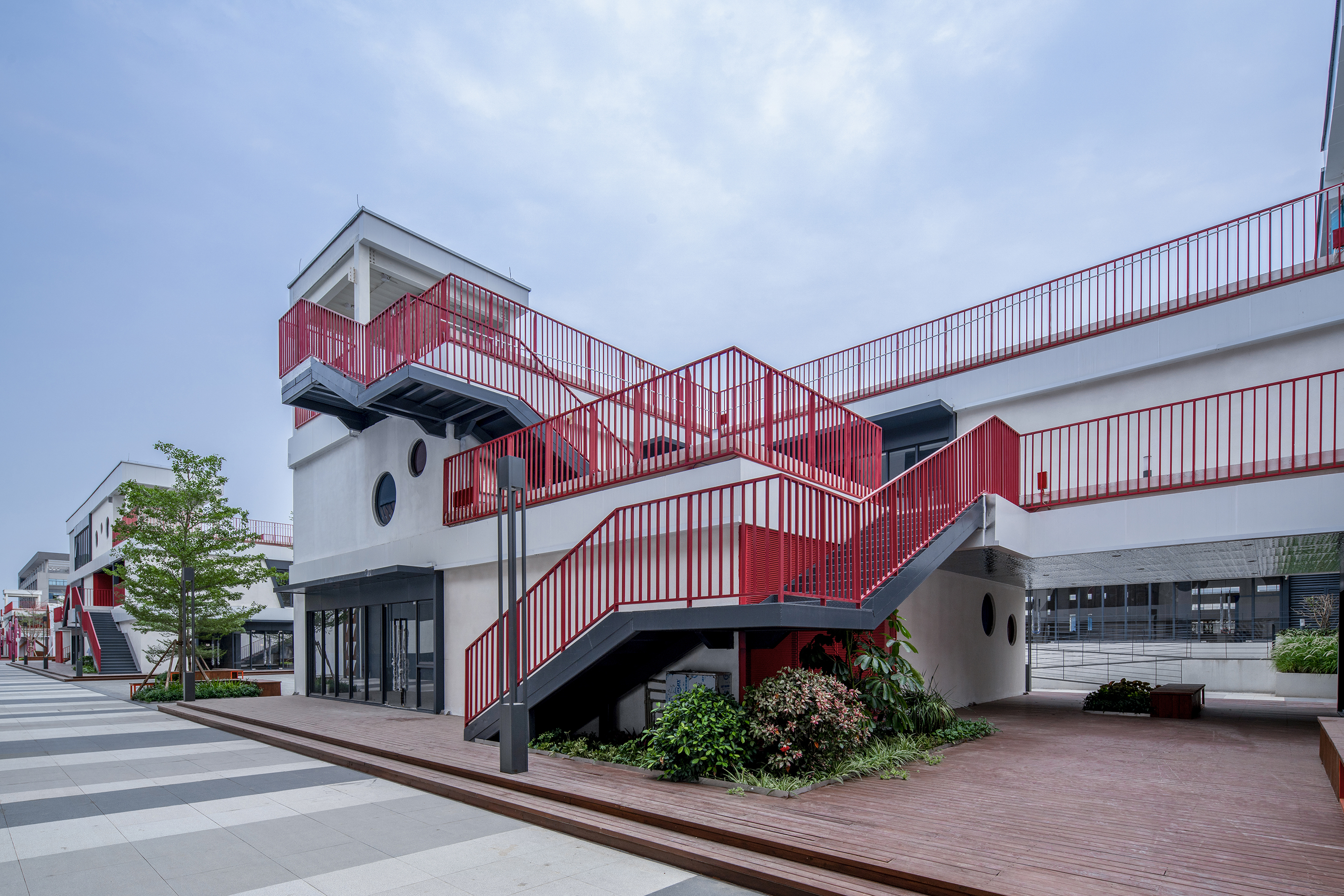

我们将中庭作为建筑整体的核心和集散中心,让人流动线在中庭处汇集中转。加入大中庭和院落空间后,整个厂房内部被划分成为不同的功能组团,然后通过在不同的组团之间增加空中连廊,我们打造了一个立体的公共空间体系,连通不同的组团以及园区内的各个建筑。建筑的墙的界限被打破,整个园区融合成为一个大的联合体,园区内部的流线和公共空间也被重新梳理。
The atrium is designed as a central circulation space and visitors are able to access differernt part of the building from here. The existing warehouse is then divided into multiple functional groups, connecting to the atrium via corridors in between. As a result, a three-dimensional public space will be created around the atrium, and the new conenctions will be built between the different functional groups inside and the surrounding architectural spaces outside. By reorganising the spaces and improving the circulation, the entire suburb will be merged into a larger complex and the boundaries between the exisitng building and the public space will be blurred and redefined.
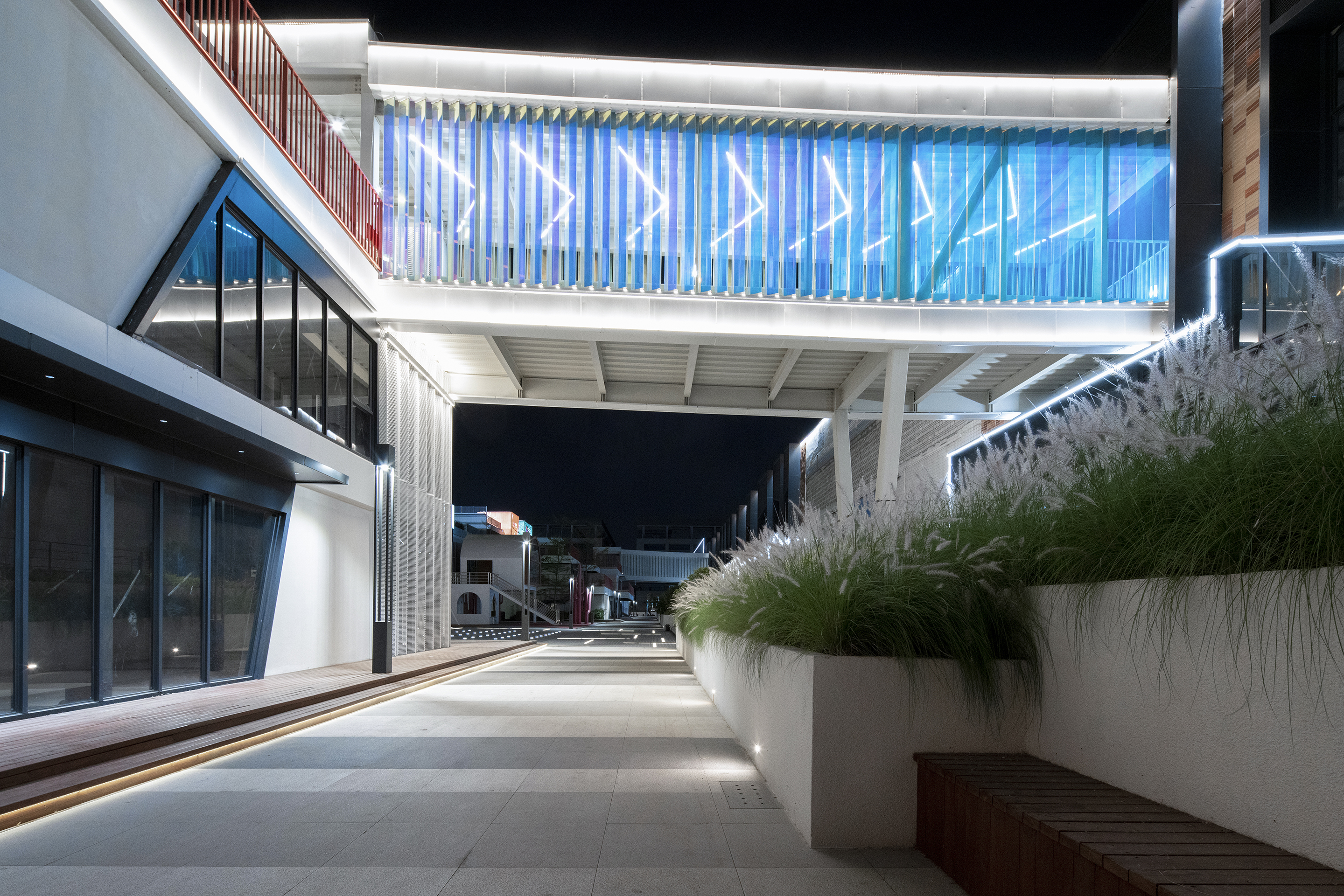
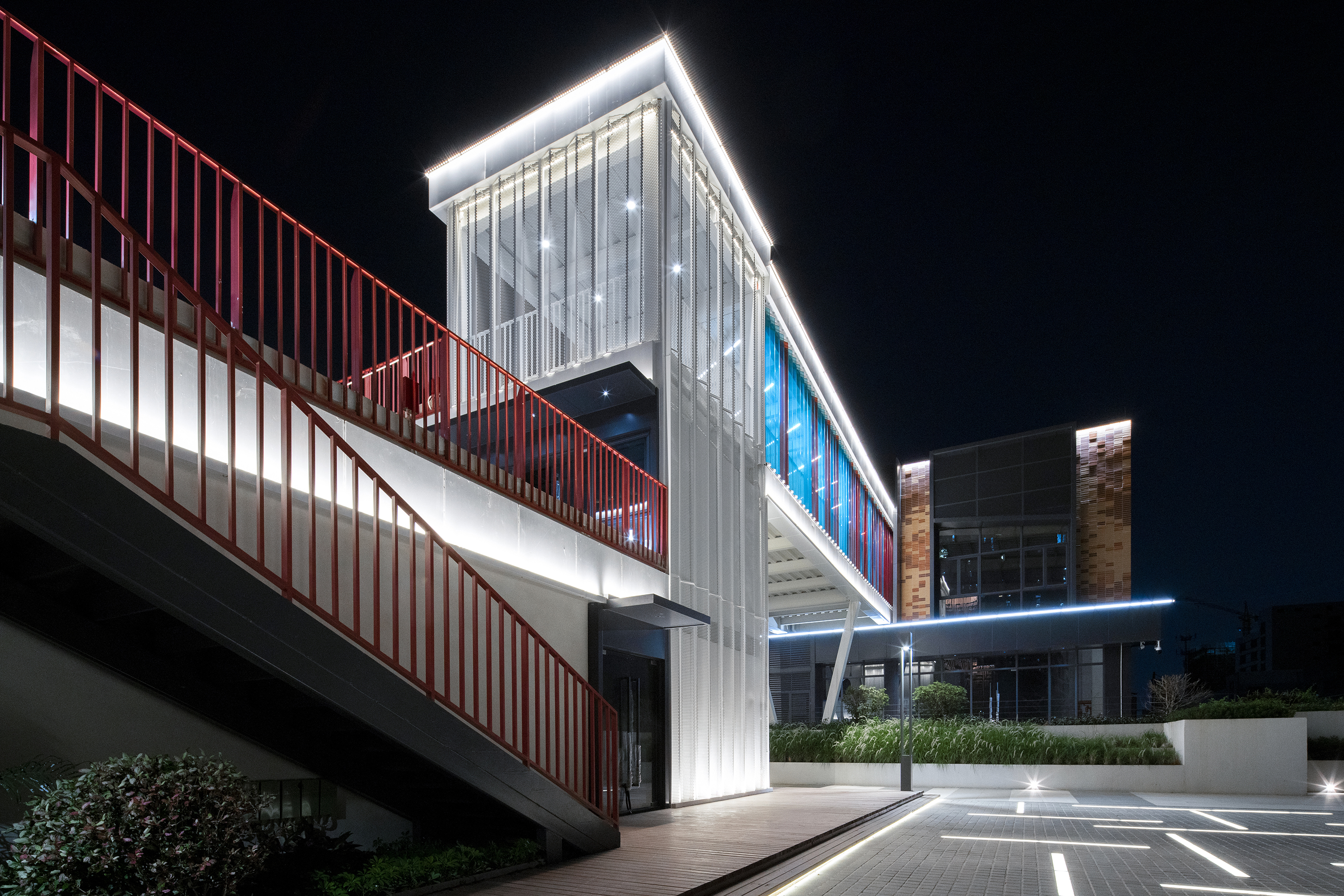
第二个尺度问题是园区内超宽的内部道路道路的。这个为重型卡车设计的道路,尺度巨大,同时没有任何绿化遮阴。在南方地区,这样的街道显然对人的使用是十分不友好的。
The second issue is to cope with the ultra-wide transition road. This pathway was designed for heavy trucks and not allowed any shades along with it. It is obviously very unfriendly in terms of the human comfort, especially in the hot and humid southern area.
我们通过置入盒子消化原有街道的大尺度,原本巨大尺度的道路分隔成两条尺度比较舒适的步行街。同时,盒子互相围合形成了小庭院空间,街道、小广场和庭院空间形成了不同空间的收放关系,增强了主动线空间的层次性和递进性。我们在园区的内部及中庭中还增加了绿化,打造低密度开放式的创意街区,创造舒适的穿越体验。
Therefore, to minimise the effects of the exising ultra-wide road, new building volumes are inserted to divide the road into two pedestrian streets with relatively comfortable scales. Followed by the different combination and the consistency of building volumes, the open spaces will be shaped as a series of courtyards. It not only creates a retractable relationship between the streets, the squares and the courtyards, but also improves the circulation between the existing buildings. Moreover, the application of the green spaces in the courtyards and the atrium, will further create a low-density open space with a pleasant visiting experience.
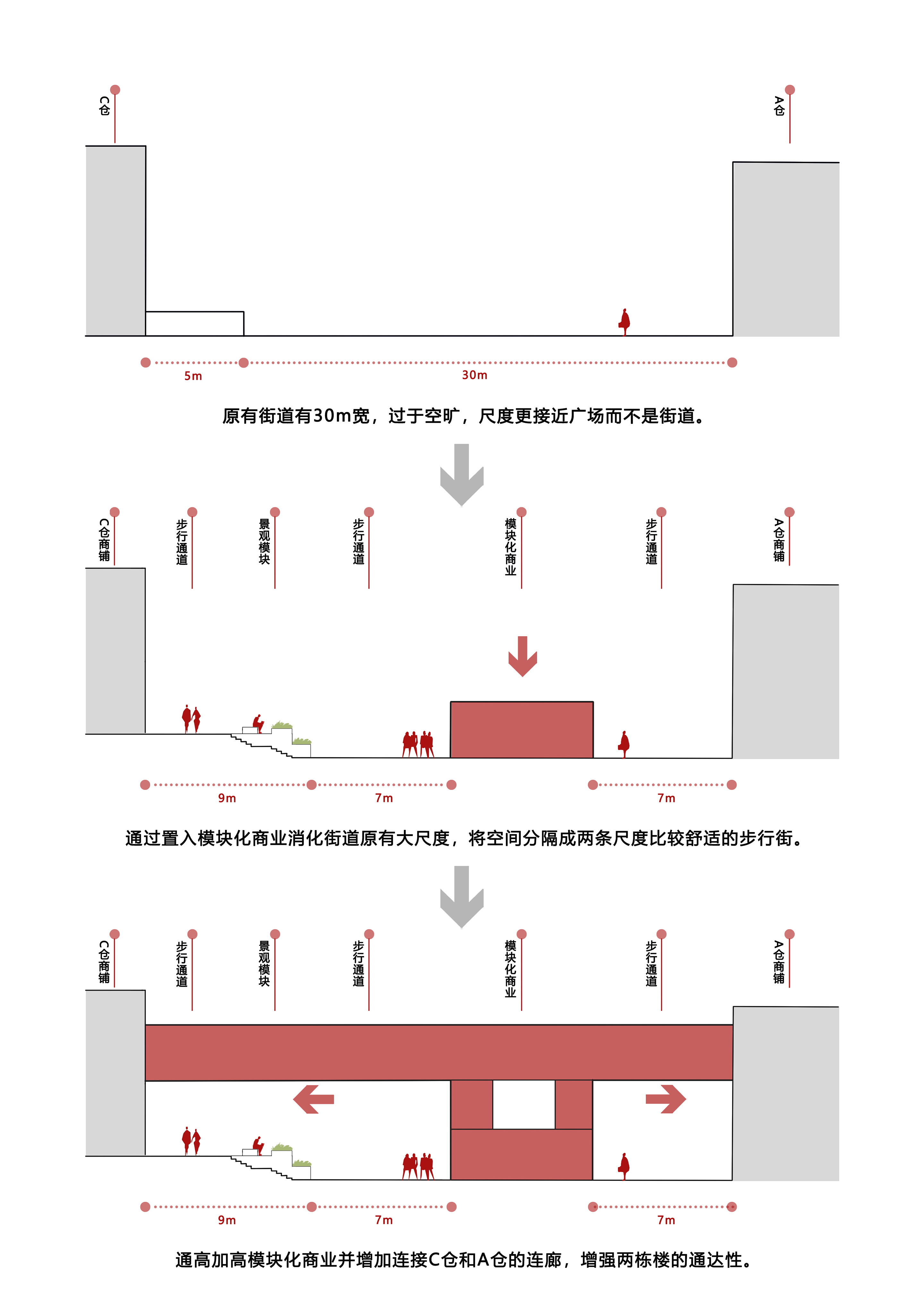
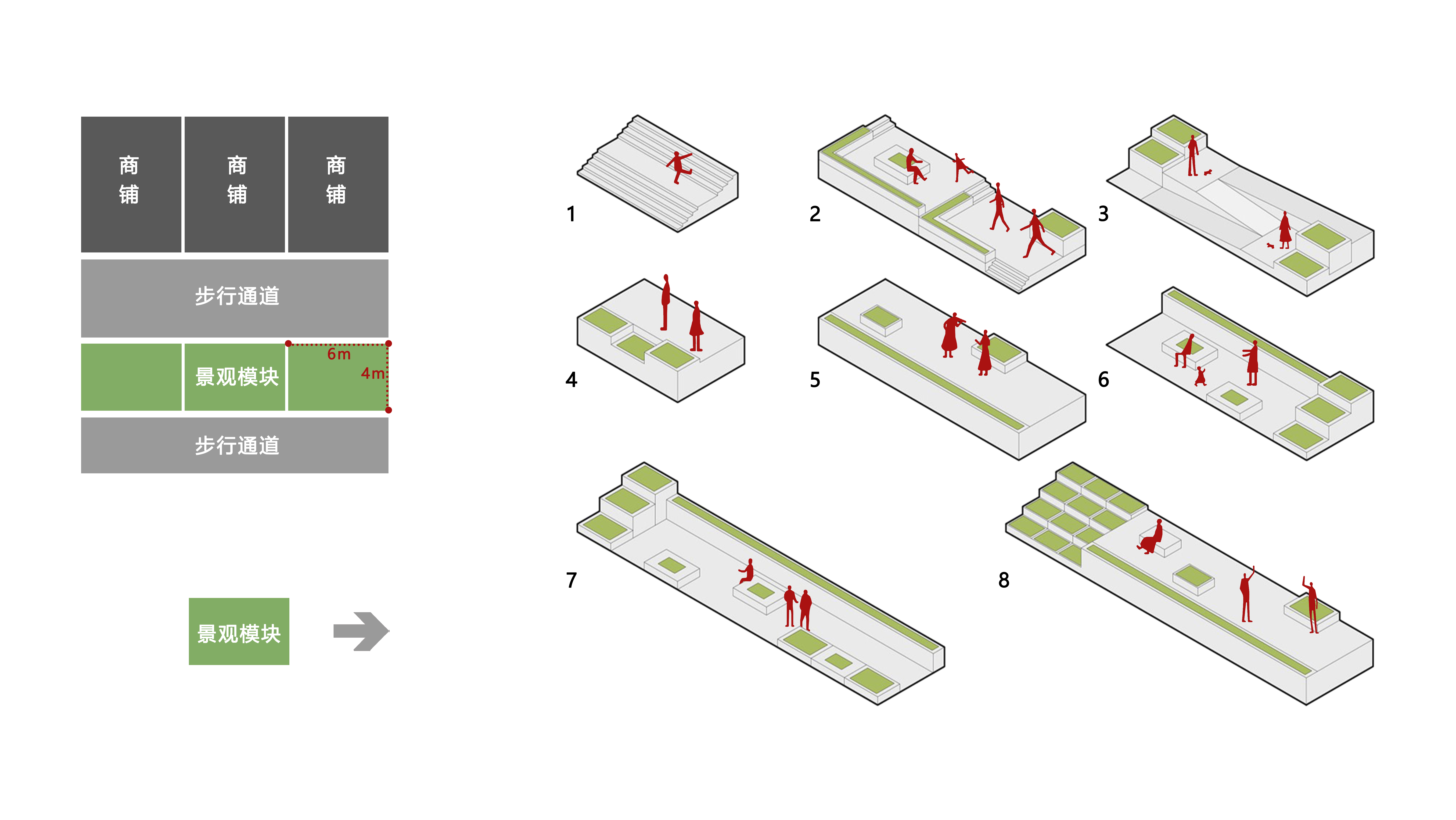
外立面特色砖墙
项目现状的仓库从建筑角度上并没有太多的特色,我们在改造的过程中,提取具有象征意义的工业符号运用在改造中,希望这些仓房能作为工业时代的见证保留下来,留住工业记忆的同时用创意带来新生。为保持工业印记和外立面的统一,园区建筑外立面设计均采用了多种做法的砖墙设计。
The existing façade has merely architectural features. Therefore, through the renovation process, the symbolic industrial symbols are extracted and applied to the propsed facade. It is hoped that the existing structure can be preserved as a memory of the industrial age and an inspiration of the creativity. In order to maintain the unity of the industrial features and the façade design, a variety of brick designs is adopted.
A仓的外立面特色砖墙用钢筋穿连穿孔砖并将陶砖固定在L型钢板上,并通过扭转砖至不同角度,实现立面不同图案的变换。
Building A - The characteristic brick wall is applied to the façade and the perforated bricks are connected with steel bars, fixing on the L-plates. By twisting the bricks with different angles, a variety of brick patterns is illustrated on the facade.
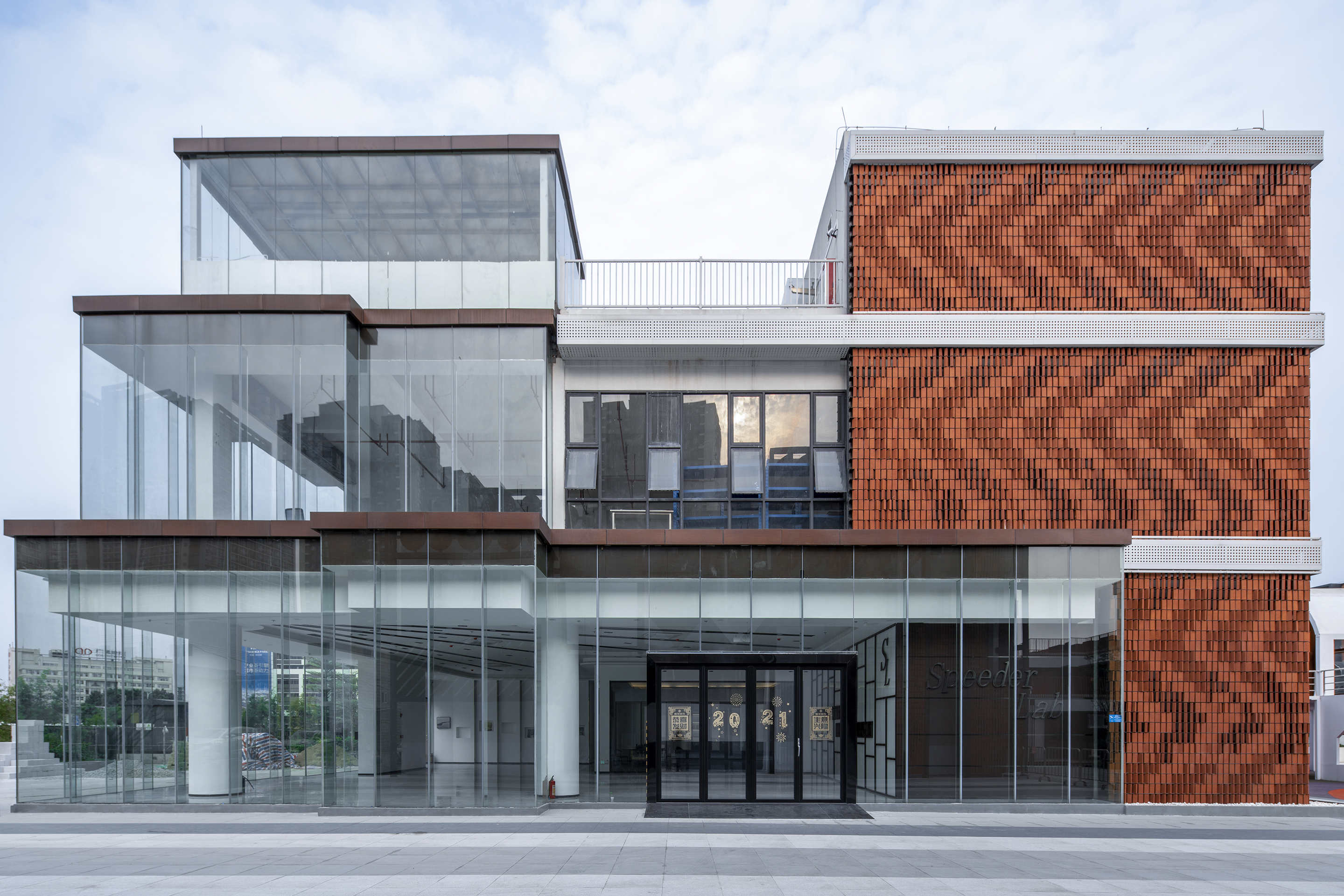
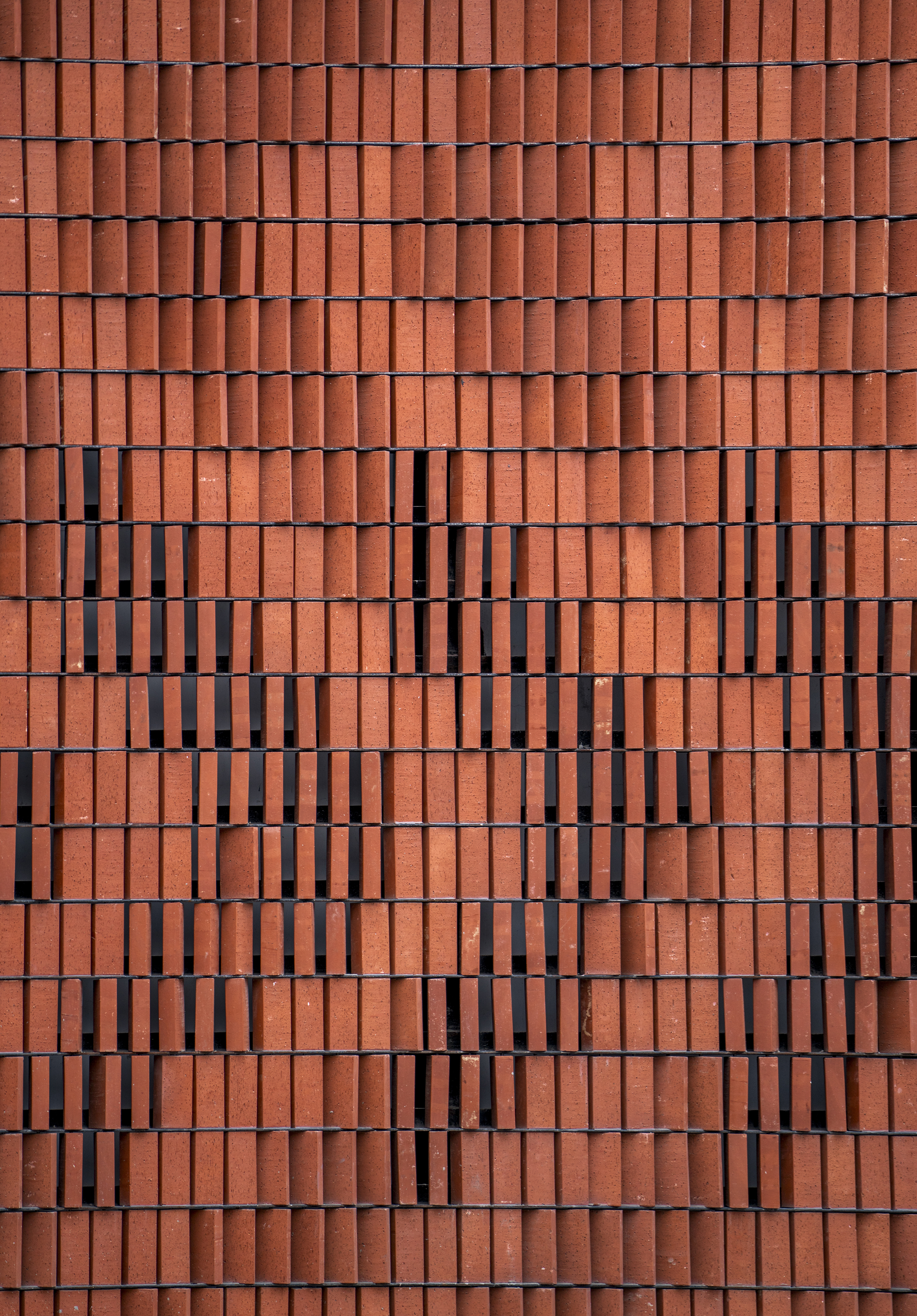
B仓外立面使用同样的做法并增加了镂空造型锈钢板搭配特色砖墙,制造了丰富的立面视觉效果。
Building B - The façade adopts the same construction method as Building A and further introduces hollowed rust steel plates and the characteristic brick walls, to create a rich façade visual effect.
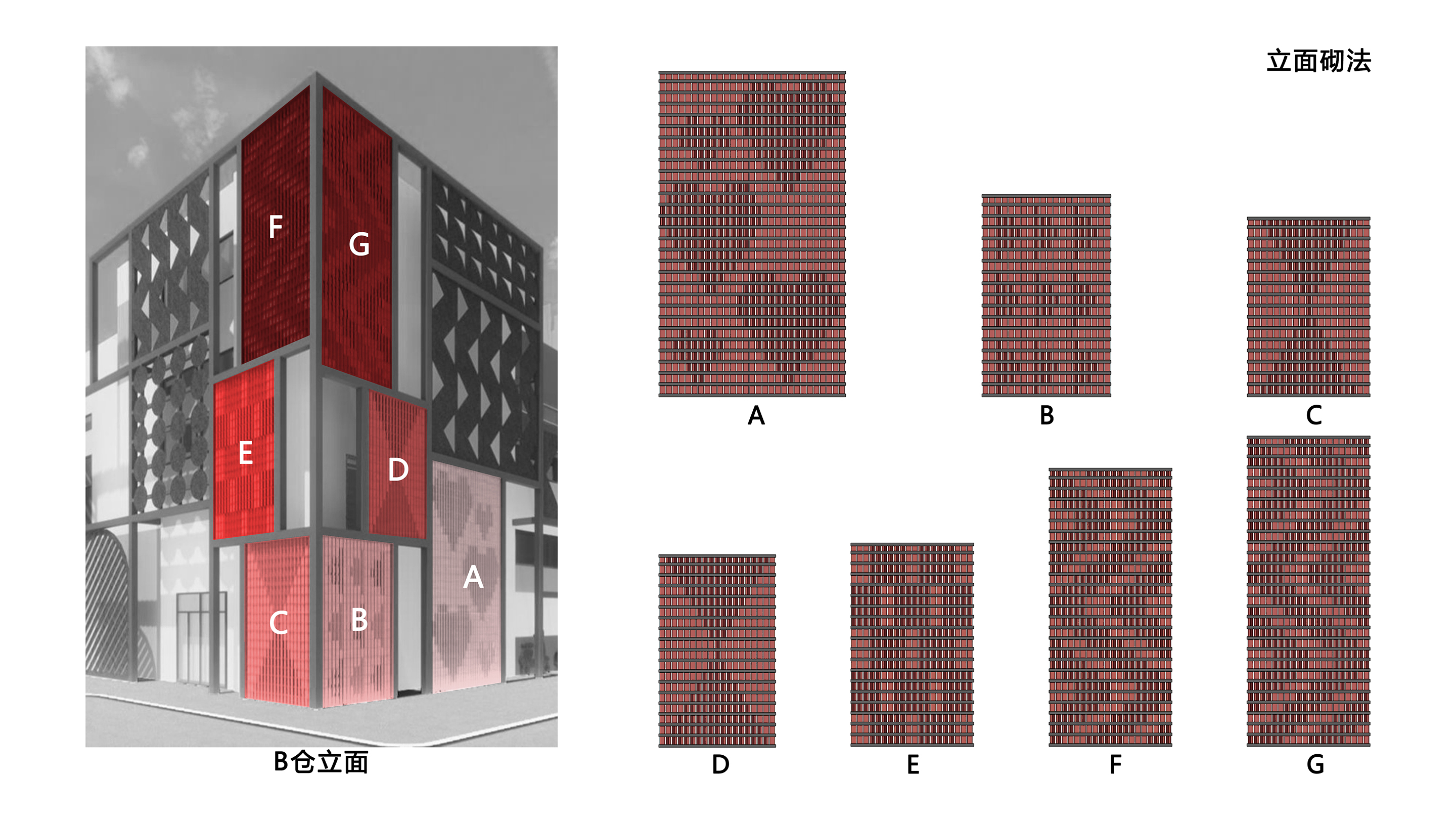
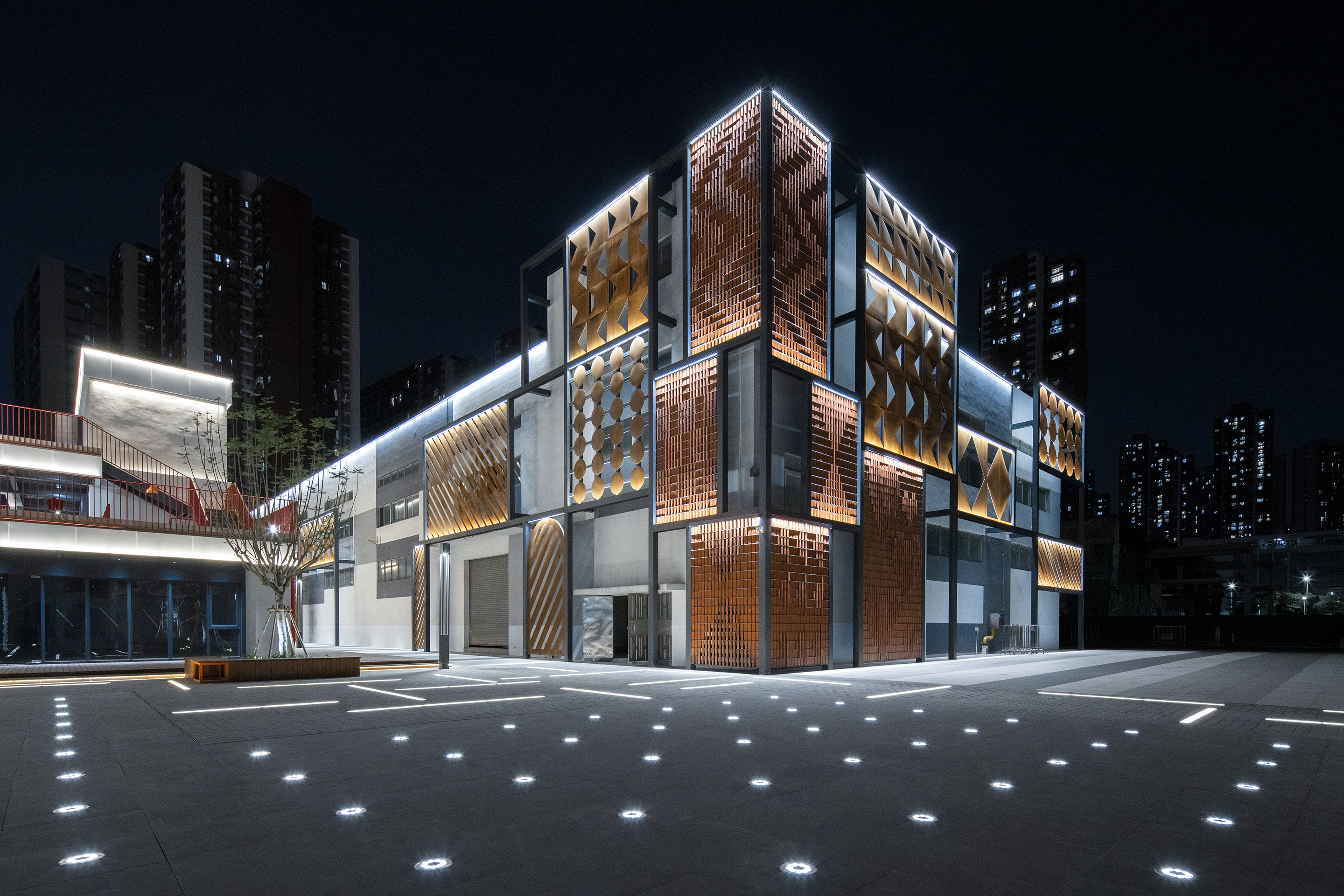
C仓特色砖墙由三种不同颜色的砖块组成,根据砖墙的宽度分成六组模版,每个模版都在一个拼贴图案的母版上截取不同的部分图案进行拼贴。
Building C - The characteristic brick wall of the proposed building is composed of bricks with three different colors, which are divided into six groups of templates according to the width of the brick wall.

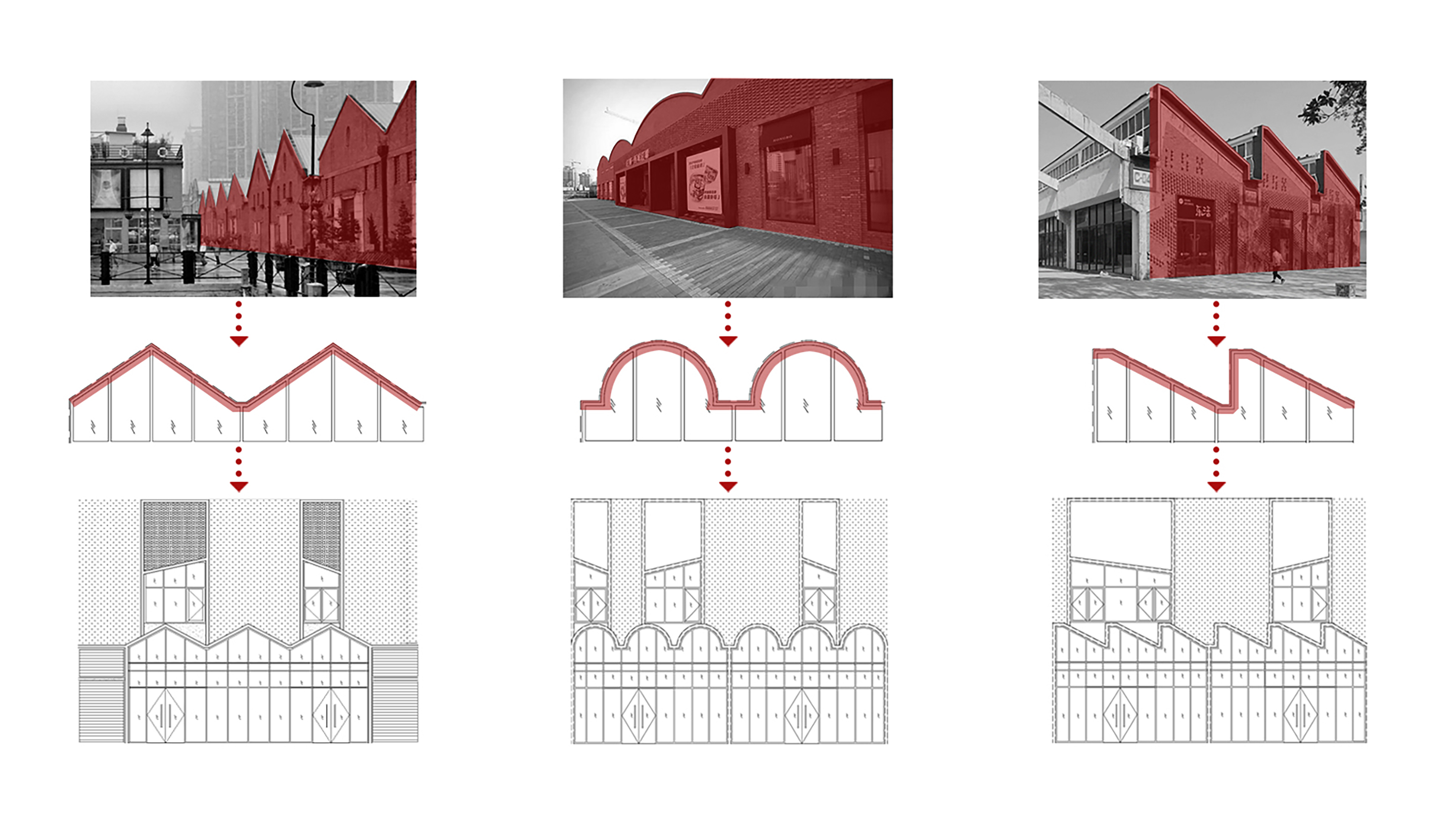

因为拼贴砖墙的体量较大,施工的过程中精准还原每个图案是很困难的,所以我们在设计的过程中考虑了砖墙施工的容错,施工只需保证砖墙拼贴色块的大走向与不同颜色砖块的比例同拼贴图案相一致。因此每面特色砖墙效果一致却又有细微差别,增加外立面的层次性和丰富性。
However, because of the large volume of construction, it is very difficult to ensure the accuracy during the assemblage. Therefore, in order to reduce the construction diffculties, the tolerance of brick wall construction is considered in the design stage. As long as the overall orientation of the bricks and the proportions of the different colored bricks are consistent with the templates, any subtle differences are allowed in the construction process. As a result, each characteristic brick wall will have a consistent effect but subtle differences, increasing the diversity and dynamism of the façade.

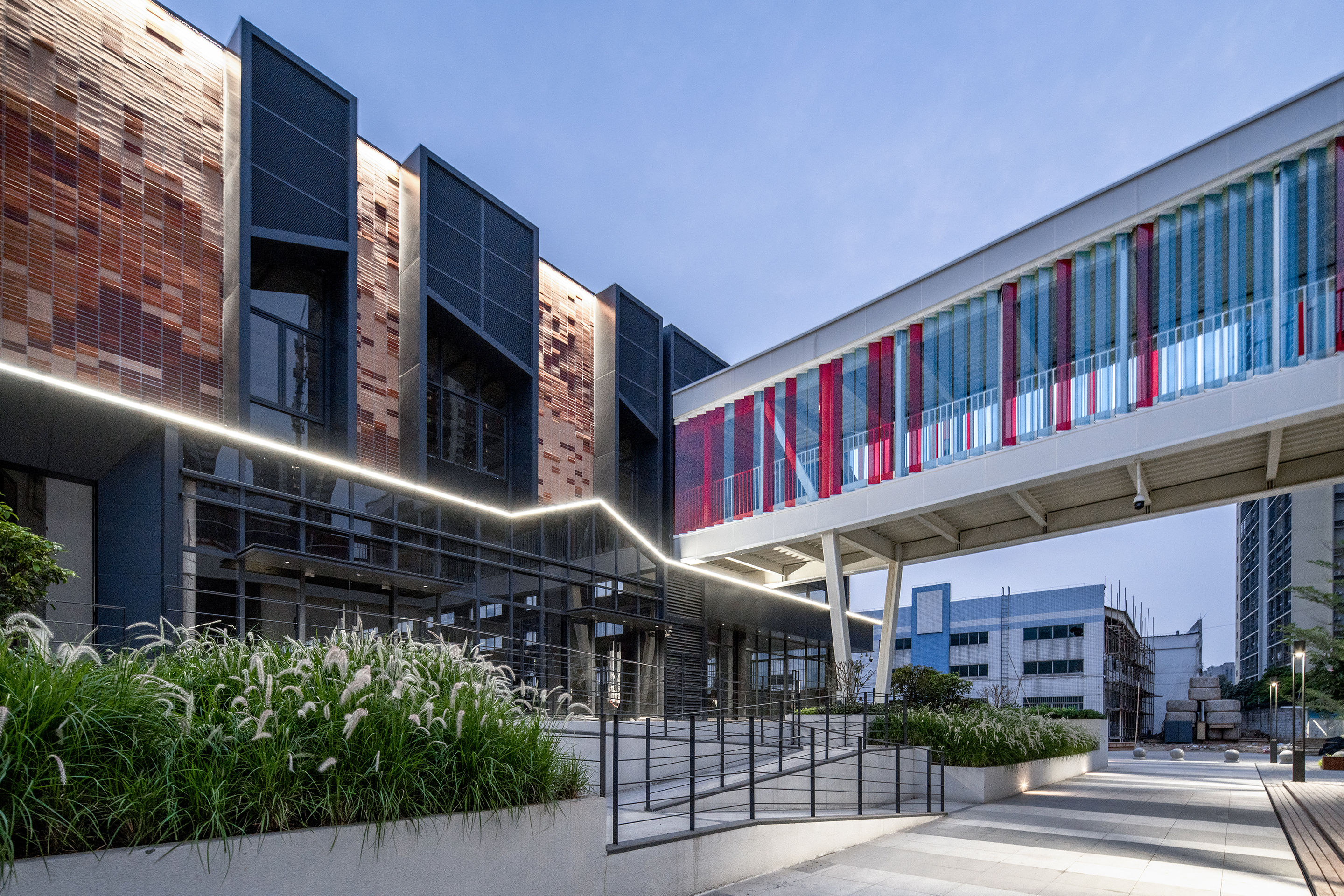
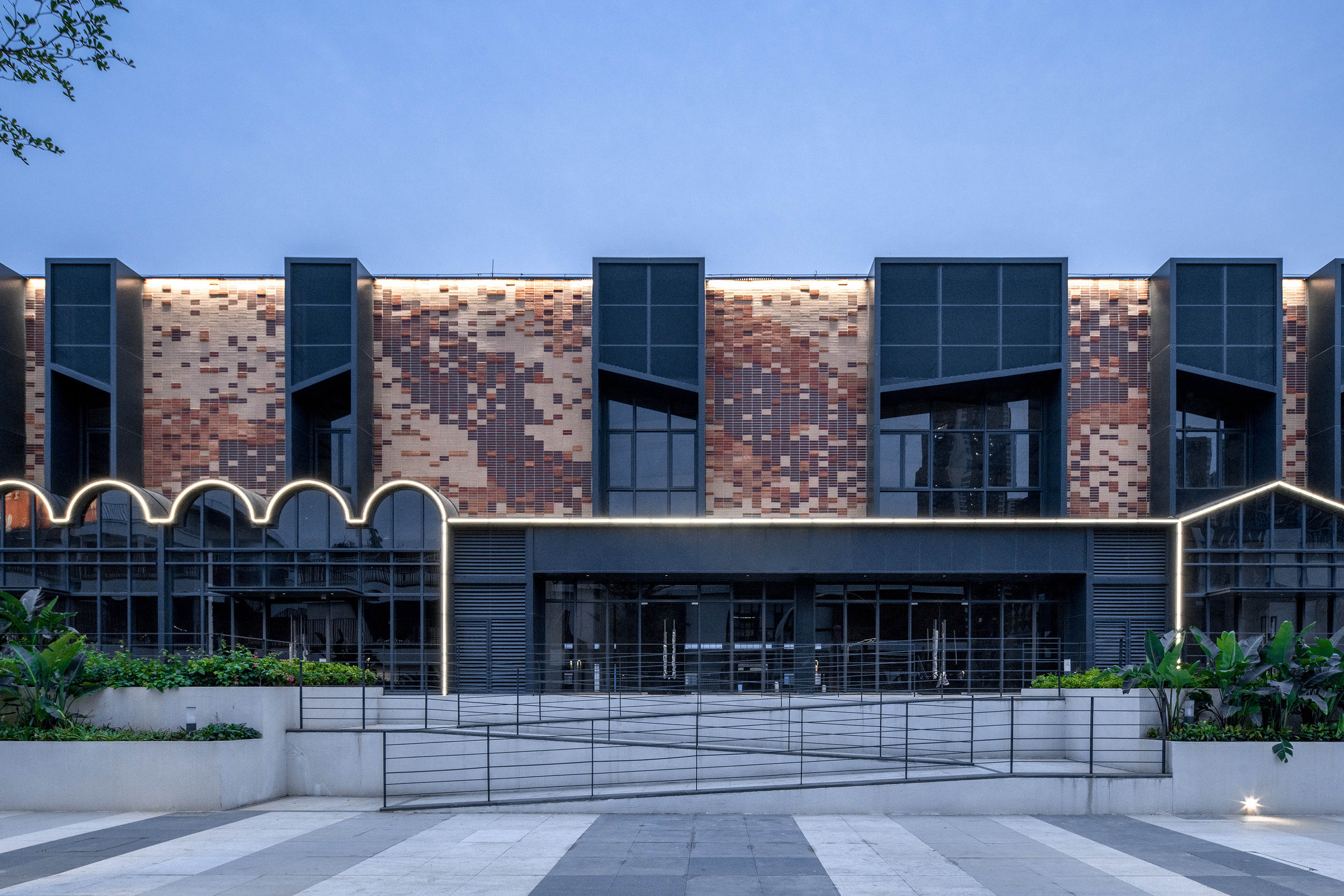


新材料的运用
在外立面的改造中,我们在局部重点位置置入了一些特色材料如炫彩玻璃、波纹不锈钢和穿孔铝板等新材料,形成了丰富的立面变化。
In the renovation of the façade, a few new materials are selected and applied to create a dynamic façade - such as colorful glass, corrugated stainless steel and perforated aluminum plate.

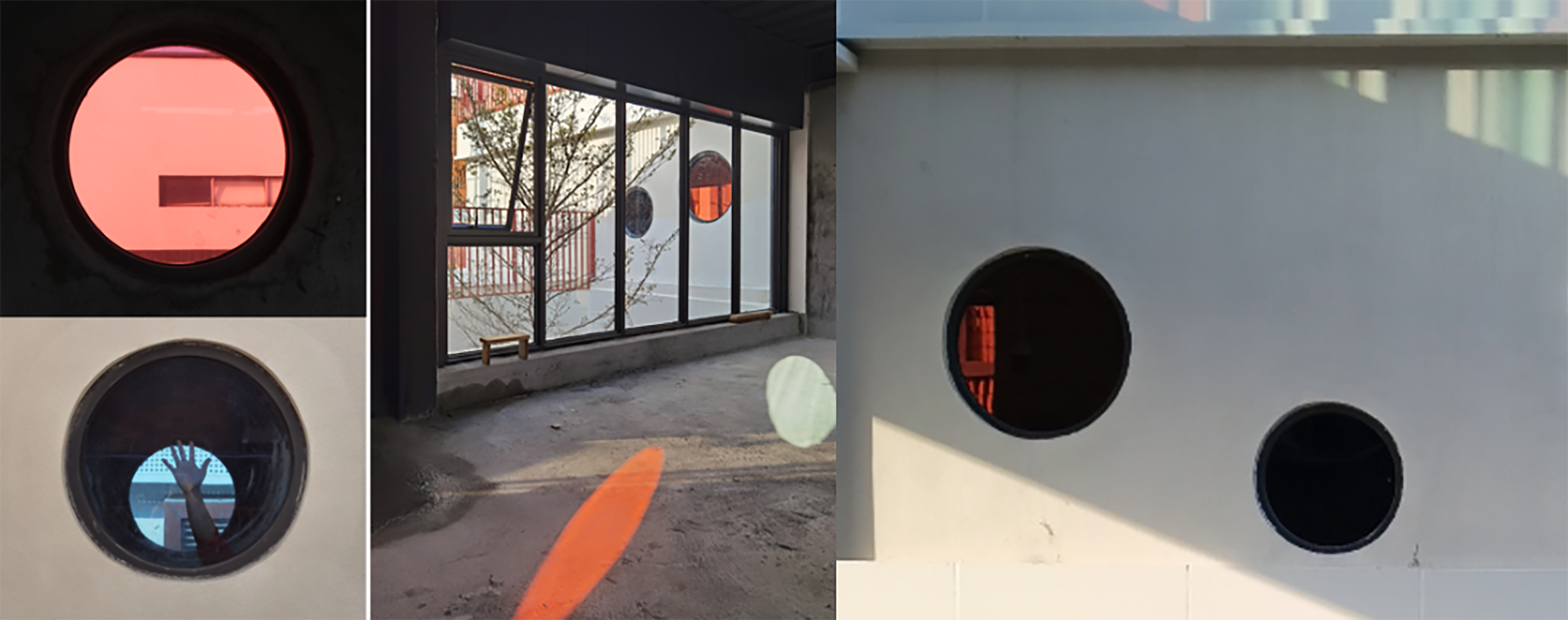

同时,在人行主入口的位置,C仓东北转角的外立面使用了渐变穿孔铝板。通过参数化控制穿孔大小展现与室内功能新科技新互联相关的折线图案,并通过加入不同的灯光强化渐变效果,这一立面设计变为园区主入口的“标志物”。 园区通过新材料的材质、颜色和角度等创新组合,打造了具有沉浸式体验的特色体验空间,为园区吸引更多的人流。
Simultaneously, at the northeast corner of the Building C, a gradient perforated aluminum plate is applied to the façade of the main entrance. Through the parametric control of the size of the perforation, variable linear patterns that related to interior functions are formed to create a sense of new technology. Different lighting systems are also applied to enhance the gradient effect, making the entrance as a highlight in the complex. Overall, based on the different combinations of new materials, the application of colors and the innovative construction of brick assemblage, the facade will create a characteristic space with immersive experience, which will attract more people to visit and ensure a positive effect on the proposed complex.
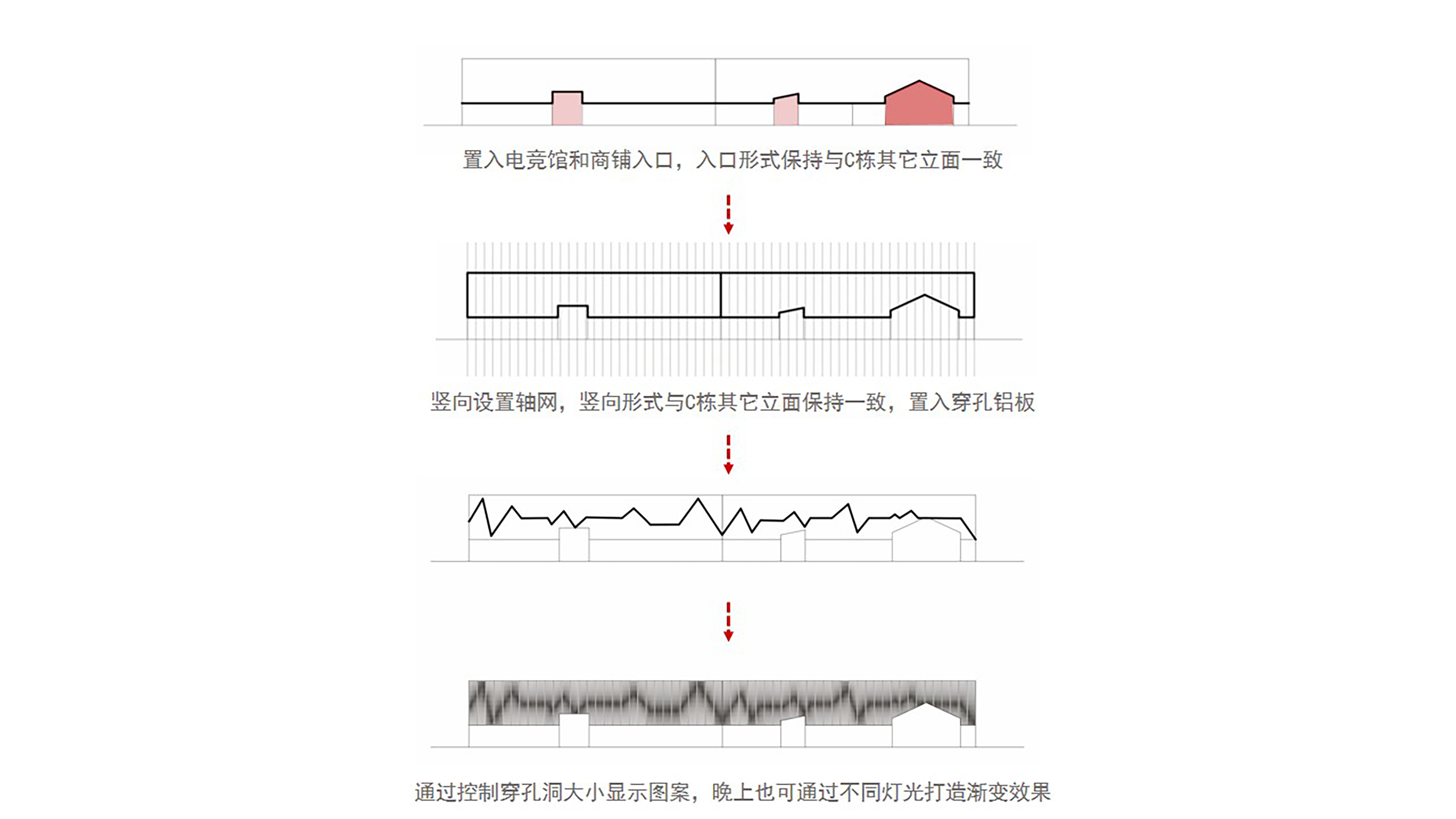



设计图纸 ▽
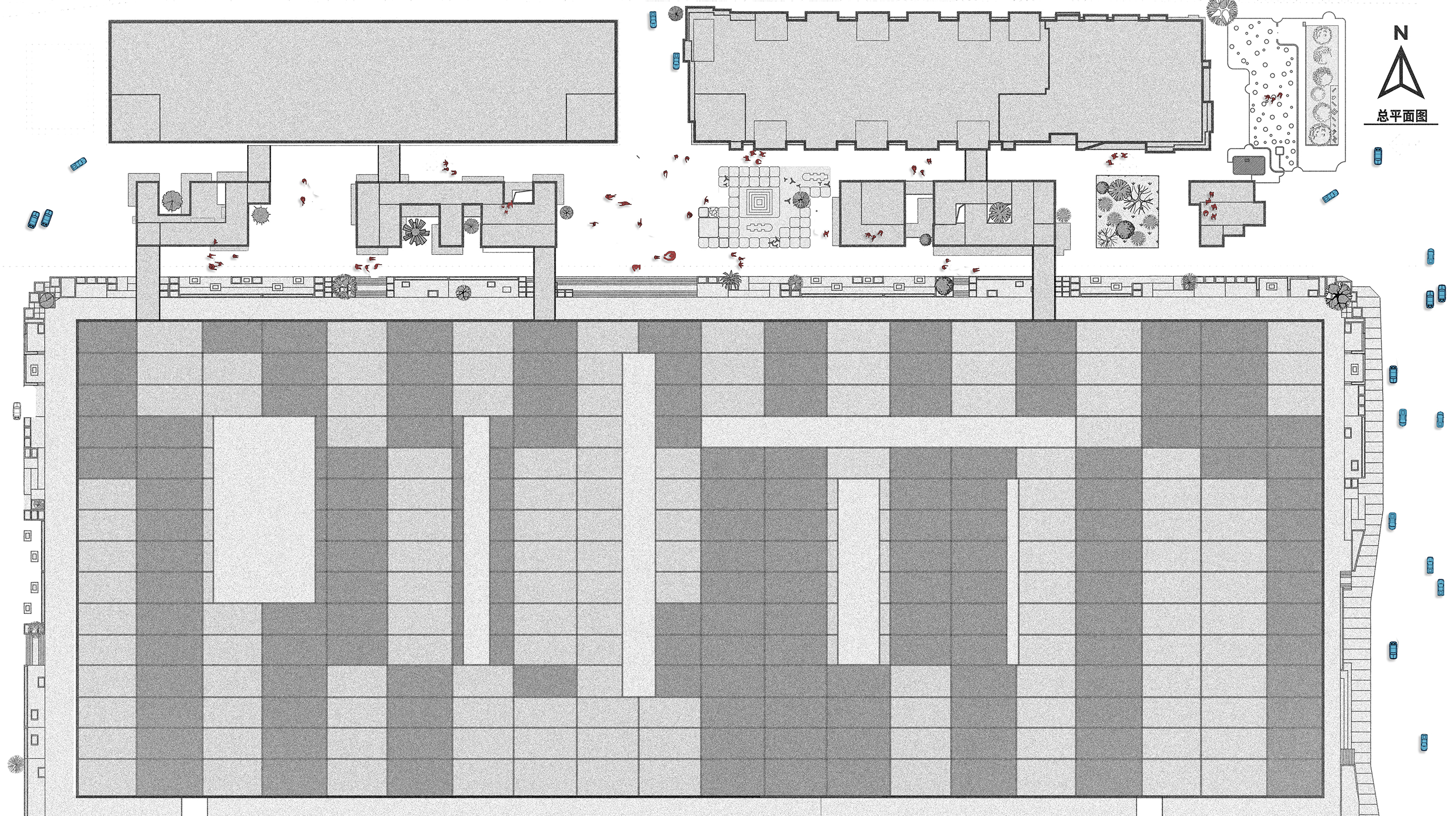
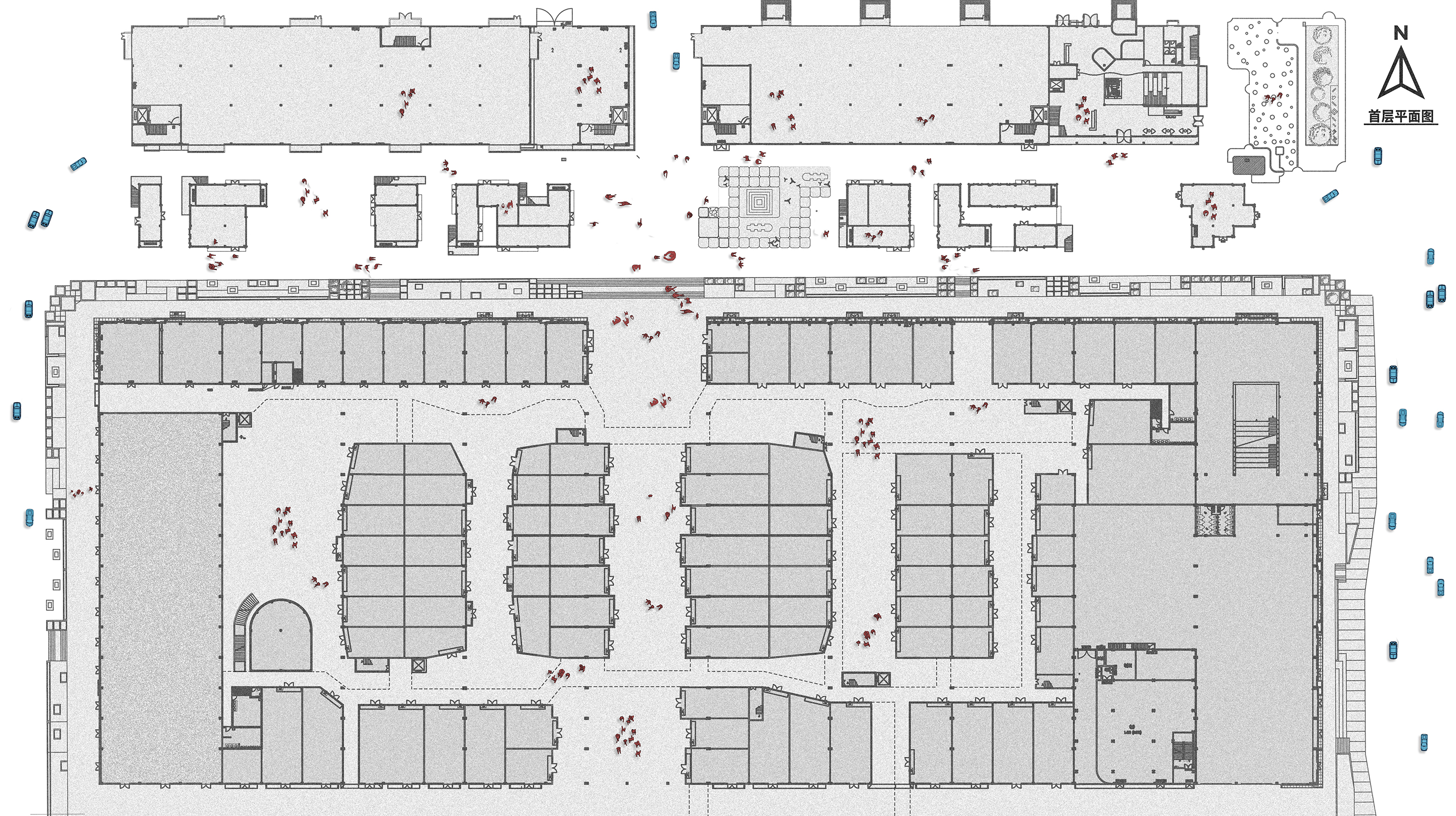
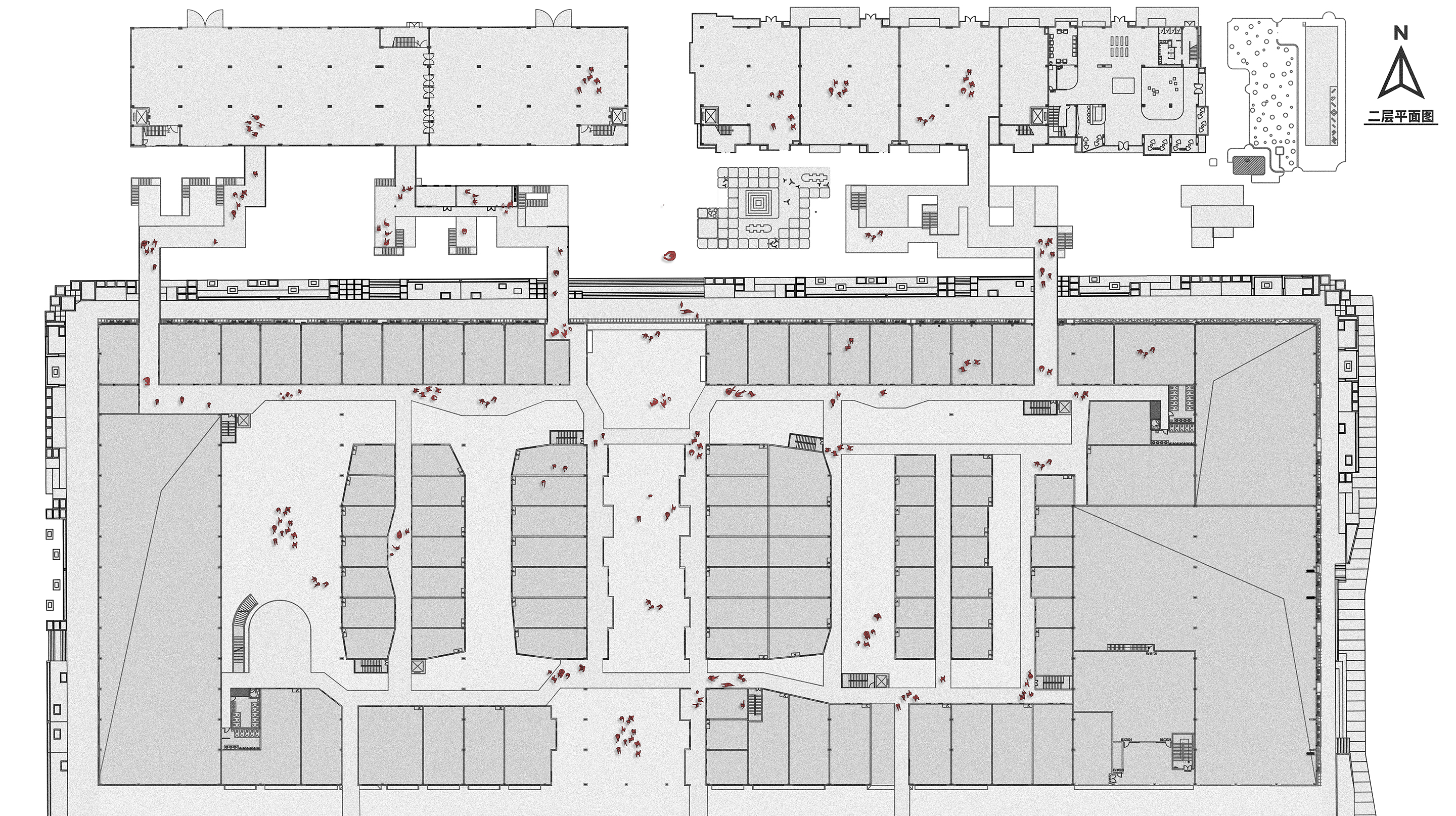
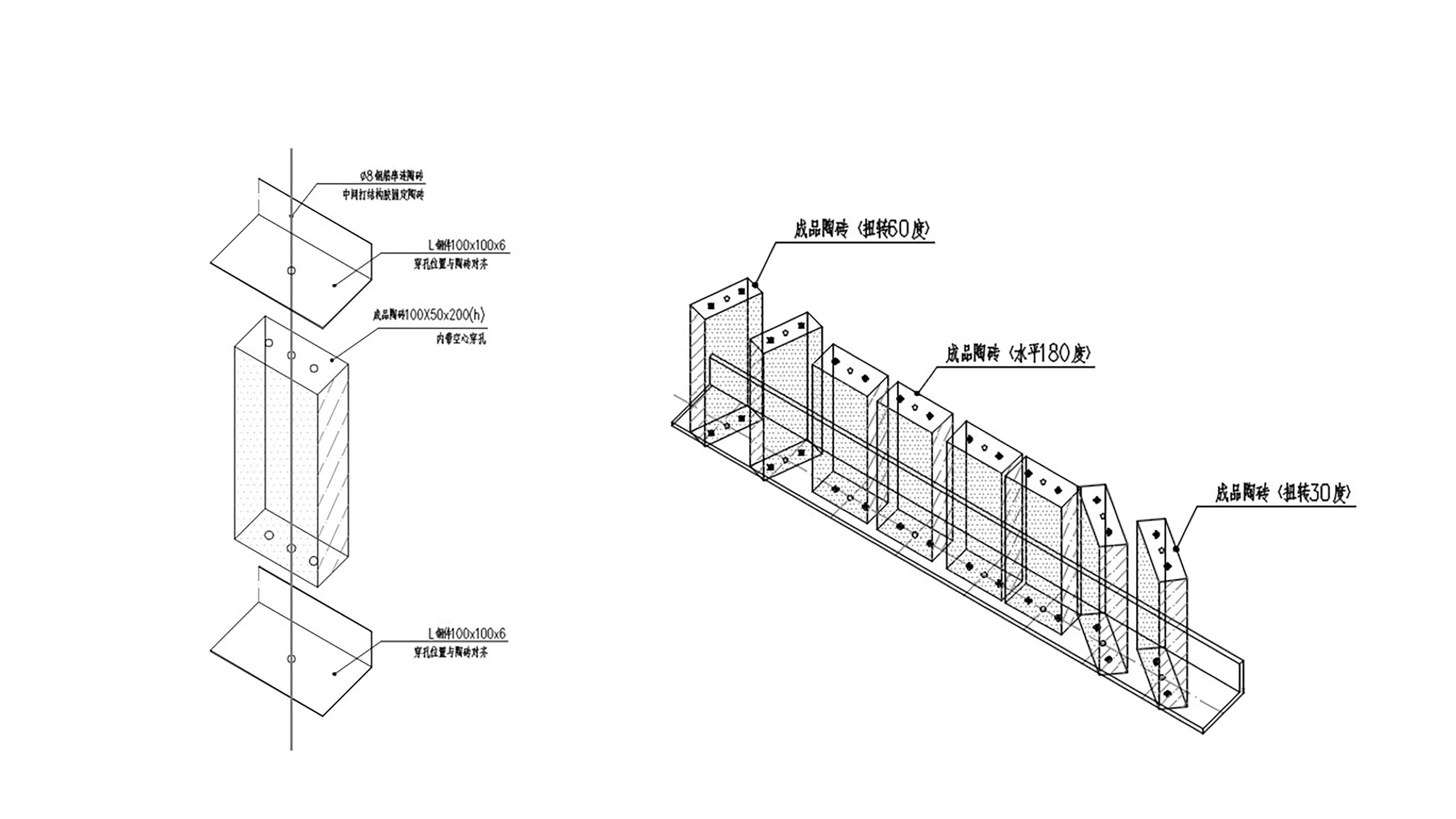
完整项目信息
项目名称:佛山南海新经济小镇
项目地点:佛山市南海区宝石西路
设计单位:竖梁社
主创建筑师:钟冠球,宋刚,朱志远
项目负责人:林海锐
设计团队:谢诗颖,李锐波,郑嘉奇,杨培彦,黄文轩,李孟昭,林东燕,梁诗曼,何永辉
业主:海逸集团
建成状态:部分已建成
设计时间:2019年5月—至今
用地面积:79000平方米
摄影:吴嗣铭
版权声明:本文由竖梁社授权发布。欢迎转发,禁止以有方编辑版本转载。
投稿邮箱:media@archiposition.com
上一篇:独白美术馆 / Wutopia Lab
下一篇:蓝天组代表作:德国UFA电影中心,体现光影的跃动